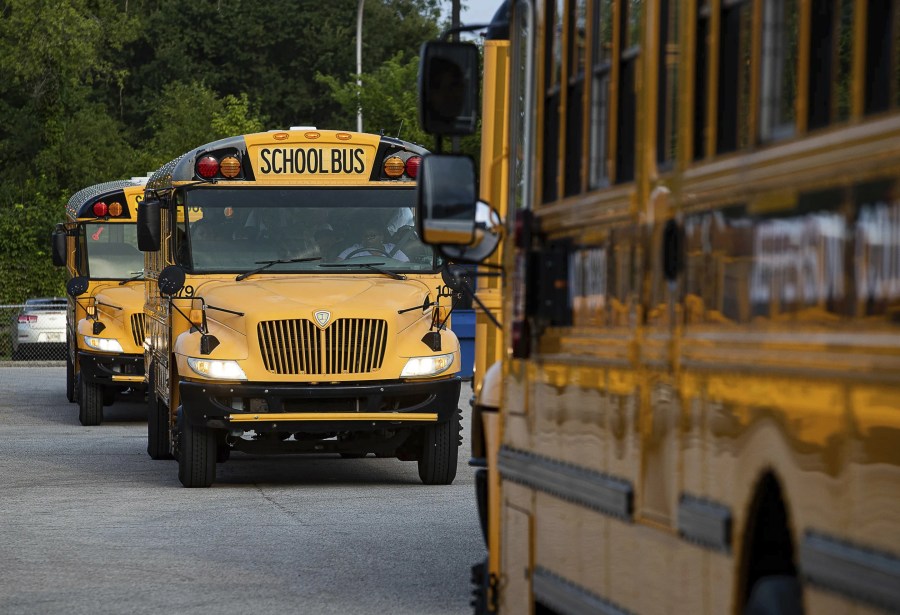Boys graduate high school at lower rates than girls, with lifelong consequences
The reasons why boys are falling short are not as clear
BUFFALO, N.Y. (AP) — They attend the same classes with access to the same programs, and even come from the same families. But girls consistently are outperforming boys, graduating at higher rates at public high schools around the country.
The gap between them is wide, often as wide as the achievement gap between students from affluent and low-income families, a problem that officials have tracked closely for years. But the reasons why boys are falling short are not as clear.
Interviews with students, educators and researchers point to several factors. Men generally can earn the same wages as women with less education. But boys also are more likely to face suspensions or other discipline knocking them off track, and they don’t pursue help as often when they face mental health challenges.

Some boys are fine when they first drop out, landing jobs providing steady incomes. But over the long term, lacking a high school degree can hold men back. Studies show young men who drop out of high school earn less over their lifetimes and are more likely to end up in jail.
Bryant West was halfway through high school in Pascagoula, Mississippi, when he dropped out in 2020. Instead of learning algebra and other things he couldn’t imagine ever needing, he felt his time was better spent working at Popeye’s and on landscaping crews to help his mother with bills.
“I feel like it was pointless,” he said.
West, 18, planned instead to earn his GED, which he received three years later, in September. “It was just another way that I wanted to do it,” he said.
In some cases, boys like West aren’t in as much of a hurry to graduate as girls because they haven’t needed a high school degree to cover rent and groceries, said Beth Jarosz, a program director at research organization PRB.
A man without a high school diploma often earns as much as a woman who has completed a year or two of college, Jarosz said.
The U.S. government doesn’t require states to report graduation data by gender the way they must break it out by racial and ethnic groups and for children with disabilities, English language learners and homeless students. But in every state reporting high school graduation rates by gender, research shows female students graduate at higher rates.
More than 45,000 fewer boys than girls graduated high school in 2018, according to an estimate by researcher Richard Reeves based on data available from 37 reporting states.
That year, about 88% of girls graduated on time compared with 82% of boys, according to Reeves, who this year left the Brookings Institution to launch the American Institute for Boys and Men. The gap was still 6 percentage points in 2021, according to a follow-up analysis this year.
The gender gap has gone largely unaddressed by schools, but some have found effective strategies.
The city of Yonkers, New York, raised graduation rates for boys of color through supports such as mentoring. Former Superintendent Edwin Quezada said addressing the racial gap in graduation rates was useful toward understanding the overall gender gap, which was 7 percentage points in 2022.
Boys are referred to special education at higher rates than girls in early grades and are suspended at higher rates throughout school, all of which can derail plans for an on-time graduation, Quezada said.
“When the decks are stacked differently for young men than they are for young ladies, why should we expect different outcomes?” asked Quezada, who retired from the district in July.

In Buffalo, Benjamin Nichols’ troubles in school started early. After his parents divorced when he was 6, he started acting out and was held back. By the time he turned things around in high school, Nichols was older than his classmates and a better fit for an accelerated-credit night program, he said. He enrolled, only to be told the program was being shut down.
“I was lashing out because I wasn’t OK,” said Nichols, who ended up leaving high school after ninth grade. “The more and more of me getting punished and reprimanded, I just lashed out more.”
There would be more than 10 years of starts and stops before he earned his GED in 2019. Nichols, now 33, earned a two-year degree in electrical construction and maintenance this past year.
“The best piece of advice that I probably would have given teachers back then when dealing with me is to ask if I’m OK,” he said. “No one even bothered really to ask the question.”
Like Yonkers, Buffalo schools have incorporated initiatives from “My Brother’s Keeper,” the program started by former President Barack Obama to help boys succeed in school. Buffalo also has enlisted education advocacy group Say Yes Buffalo to provide mentoring to male students and recruit men to teach, spokesman Jeffrey Hammond said. Still, the urban district posted a 10-point graduation gender gap in 2022 (84%-74%) and an 11-point gap (84%-73%) in 2021.
Research is clear, Hammond wrote in an email: “Girls nationally succeed in school over boys because they are more apt to plan ahead, set academic goals and put forth effort in achieving these goals.” Plus, he said, girls receive fewer school suspensions, showing they are generally more likely to follow rules and receive more close instruction from teachers.
Only 10 states reporting graduation rates by gender break it down further by race, making it difficult to understand how much race is a factor in the gender gap. But Reeves found in his latest analysis that the gender gaps in the five largest states in the group were much larger between Black girls and boys than they were between white girls and boys or Asian girls and boys.
The graduation gender gap “is harder to explain than some of the other disparities we see,” PRB’s Jarosz said. “We know that structural racism is part of the explanation for why Black youth and Hispanic, Latino youth and American Indian youth are less likely to graduate.”
“But it’s not a structural racism issue for boys versus girls,” she said.
TheGrio is FREE on your TV via Apple TV, Amazon Fire, Roku and Android TV. Also, please download theGrio mobile apps today!


